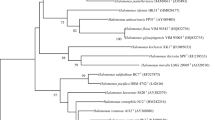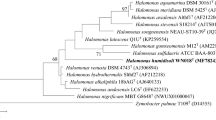Abstract
A Gram-staining-negative, halophilic, aerobic, oval-shaped or vibrio-shaped, motile by a polar flagellum strain, designated YL5-2T, was isolated from natural saline-alkaline wetland soil of Binhai new district, Tianjin, China. Strain YL5-2T grew optimally at 35 °C, pH 7.5–8.0, and in the presence of 10–25% (w/v) NaCl on MA medium. Phylogenetic analyses based on 16S rRNA gene sequences showed that the isolate belonged to the genus Halovibrio and exhibited high sequence similarity of 97.7% to Halovibrio variabilis DSM 3050T. The sole respiratory ubiquinone of strain YL5-2T is Q-9, and the dominant fatty acids were C18:1ω9c, C16:0, C19:0 cycloω8c, and Summed Feature 8. The major polar lipids were diphosphatidylglycerol (DPG), phosphatidylethanolamine (PE), phosphatidylglycerol (PG), phosphatidylcholine (PC), and lipid (L). The DNA G+C content of the strain was 62.1 mol%. The average nucleotide identity (ANI) based on whole genome sequences of strain YL5-2T and Halovibrio variabilis DSM 3050T was 93.85%, and the dDDH value between these two strains was determined to be 52.0%. Phenotypic, chemotaxonomic, phylogenetic, and genomic analyses suggested that strain YL5-2T represent a novel species of the genus Halovibrio, for which the name Halovibrio salipaludis sp. nov. is proposed. The type strain is YL5-2T (=KCTC 52852T=ACCC 19971T).

Similar content being viewed by others
References
Fendrich C (1988) Halovibrio variabilis gen. nov. sp. nov., Pseudomonas halophilasp. nov. and a new halophilic aerobic coccoid eubacterium from Great Salt Lake, Utah, USA. Syst Appl Microbiol 11:36–43
Sorokin DY, Tourova TP, Galinski EA, Belloch C, Tindall BJ (2006) Extremely halophilic denitrifying bacteria from hypersaline inland lakes, Halovibrio denitrificans sp. nov. and Halospina denitrificans gen. nov., sp. nov., and evidence that the genus name Halovibrio Fendrich 1989 with the type species Halovibrio variabilis should be associated with DSM 3050. Int J Syst Evol Microbiol 56(2):379–388. https://doi.org/10.1099/ijs.0.63964-0
Anzai Y, Kim H, Park JY, Wakabayashi H, Oyaizu H (2000) Phylogenetic affiliation of the pseudomonads based on 16S rRNA sequence. Int J Syst Evol Microbiol 50(4):1563–1589. https://doi.org/10.1099/00207713-50-4-1563
Minnikin DE, O’Donnell AG, Goodfellow M, Alderson G, Athalye M, Schaal A, Parlett JH (1984) An integrated procedure for the extraction of bacterial isoprenoid quinones and polar lipids. J Microbiol Methods 2(5):233–241. https://doi.org/10.1016/0167-7012(84)90018-6
Miller LT (1982) Single derivatization method for routine analysis of bacterial whole-cell fatty acid methyl esters, including hydroxy acids. J Clin Microbiol 16(3):584–586
Bligh EG, Dyer WJ (1959) A rapid method of total lipid extraction and purification. Can J Biochem Physiol 37(8):911–917. https://doi.org/10.1139/o59-099
Kroppenstedt RM (1982) Separation of bacterial menaquinones by HPLC using reverse phase (RP18) and a silver loaded ion exchanger as stationary phases. J Liq Chromatogr 5(12):2359–2367. https://doi.org/10.1080/01483918208067640
Thompson JD, Gibson TJ, Plewniak F, Jeanmougin F, Higgins DG (1997) The CLUSTAL_X windows interface: flexible strategies for multiple sequence alignment aided by quality analysis tools. Nucleic Acids Res 25(24):4876–4882. https://doi.org/10.1093/nar/25.24.4876
Tamura K, Stecher G, Peterson D, Filipski A, Kumar S (2013) MEGA6: molecular evolutionary genetics analysis version 6.0. Mol Biol Evol 30(12):2725–2729. https://doi.org/10.1093/molbev/mst197
Zharkikh A, Li WH (1995) Estimation of confidence in phylogeny: the complete-and-partial bootstrap technique. Mol Phylogen Evol 4(1):44–63. https://doi.org/10.1006/mpev.1995.1005
Schmieder R, Edwards R (2011) Quality control and preprocessing of metagenomic datasets. Bioinformatics 27(6):863–864. https://doi.org/10.1093/bioinformatics/btr026
Li R, Li Y, Kristiansen K, Wang J (2008) SOAP: short oligonucleotide alignment program. Bioinformatics 24(5):713–714. https://doi.org/10.1093/bioinformatics/btn025
Li R, Zhu H, Ruan J, Qian W, Fang X, Shi Z, Li Y, Li S, Shan G, Kristiansen K, Li S, Yang H, Wang J, Wang J (2010) De novo assembly of human genomes with massively parallel short read sequencing. Genome Res 20(2):265–272. https://doi.org/10.1101/gr.097261.109
Parks DH, Imelfort M, Skennerton CT, Hugenholtz P, Tyson GW (2015) CheckM: assessing the quality of microbial genomes recovered from isolates, single cells, and metagenomes. Genome Res 25(7):1043–1055. https://doi.org/10.1101/gr.186072.114
Delcher AL, Bratke KA, Powers EC, Salzberg SL (2007) Identifying bacterial genes and endosymbiont DNA with Glimmer. Bioinformatics 23(6):673–679. https://doi.org/10.1093/bioinformatics/btm009
Lagesen K, Hallin P, Rødland EA, Staerfeldt HH, Rognes T, Ussery DW (2007) RNAmmer: consistent and rapid annotation of ribosomal RNA genes. Nucleic Acids Res 35(9):3100–3108. https://doi.org/10.1093/nar/gkm160
Lowe TM, Eddy SR (1997) tRNAscan-SE: a program for improved detection of transfer RNA genes in genomic sequence. Nucleic Acids Res 25(5):955–964. https://doi.org/10.1093/nar/25.5.955
Auch AF, von Jan M, Klenk HP, Göker M (2010) Digital DNA-DNA hybridization for microbial species delineation by means of genome-to-genome sequence comparison. Stand Genomic Sci 2(1):117–134. https://doi.org/10.4056/sigs.531120
Meier-Kolthoff JP, Auch AF, Klenk HP, Göker M (2013) Genome sequence-based species delimitation with confidence intervals and improved distance functions. BMC Bioinform 14:60. https://doi.org/10.1186/1471-2105-14-60
Goris J, Konstantinidis KT, Klappenbach JA, Coenye T, Vandamme P, Tiedje JM (2007) DNA-DNA hybridization values and their relationship to whole-genome sequence similarities. Int J Syst Evol Microbiol 57(Pt1):81–91. https://doi.org/10.1099/ijs.0.64483-0
Blin K, Medema MH, Kazempour D, Fischbach MA, Breitling R, Takano E, Weber T (2013) antiSMASH 2.0—A versatile platform for genome mining of secondary metabolite producers. Nucleic Acids Res 41:W204–W212. https://doi.org/10.1093/nar/gkt449
Chun J, Oren A, Ventosa A, Christensen H, Arahal DR, da Costa MS, Rooney AP, Yi H, Xu XW, De Meyer S, Trujillo ME (2018) Proposed minimal standards for the use of genome data for the taxonomy of prokaryotes. Int J Syst Evol Microbiol 68(1):461–466. https://doi.org/10.1099/ijsem.0.002516
Kim M, Oh HS, Park SC, Chun J (2014) Towards a taxonomic coherence between average nucleotide identity and 16S rRNA gene sequence similarity for species demarcation of prokaryotes. Int J Syst Evol Microbiol 64(Pt2):346–351. https://doi.org/10.1099/ijs.0.059774-0
Richter M, Rosselló-Móra R (2009) Shifting the genomic gold standard for the prokaryotic species definition. Proc Natl Acad Sci U S A 106(45):19126–19131. https://doi.org/10.1073/pnas.0906412106
Wayne LG (1988) International Committee on Systematic Bacteriology: announcement of the report of the ad hoc Committee on reconciliation of approaches to bacterial systematics. Zentralbl Bakteriol Mikrobiol Hyg A 268(4):433–434. https://doi.org/10.1016/s0176-6724(88)80120-2
Graham PH, Sadowsky MJ, Keyser HH, Barnet YM, Bradley RS, Cooper JE, De Ley DJ, Jarvis BDW, Roslycky EB, Strijdom BW, Young JPW (1991) Proposed minimal standards for the description of new genera and species of root- and stem-nodulating bacteria. Int J Syst Bacteriol 41(4):582–587. https://doi.org/10.1099/00207713-41-4-582
Reshetnikov AS, Khmelenina VN, Mustakhimov II, Trotsenko YA (2011) Genes and enzymes of ectoine biosynthesis in halotolerant methanotrophs. Methods Enzymol 495:15–30. https://doi.org/10.1016/B978-0-12-386905-0.00002-4
Acknowledgements
The authors would like to thank Prof. Aharon Oren for very valuable help in naming the organism.
Author information
Authors and Affiliations
Contributions
LT contributed to performing the experiments and writing the initial draft. WS provided samples of experiment and participated in the isolation and cultivation of strains. GZ and LM contributed to the guidance of experimental operations. HL and SM contributed to the morphological analyses. JZ and QG performed genome analysis. GZ and LM contributed to reagents, instrumentation, and the financial support for this work. All the authors approved the manuscript.
Corresponding authors
Ethics declarations
Conflict of interest
The authors declare that they have no conflict of interest.
Additional information
Publisher's Note
Springer Nature remains neutral with regard to jurisdictional claims in published maps and institutional affiliations.
The GenBank/EMBL/DDBJ accession number for the 16S rRNA gene of strain YL5-2T is MF782425. The whole genome has been deposited at DDBJ/EMBL/GenBank under the accession NSKD00000000 for strain YL5-2T. Thin-layer chromatograms of the polar lipids extracted from strain YL5-2T and closely related species, additional phylogenetic trees, and the table containing the average nucleotide identity (ANI), and dDDH values to closely related genomes are available as Supplementary Materials.
Electronic supplementary material
Below is the link to the electronic supplementary material.
Rights and permissions
About this article
Cite this article
Tang, L., Liu, H., Sun, W. et al. Halovibrio salipaludis sp. nov., Isolated from Saline-Alkaline Soil. Curr Microbiol 78, 429–434 (2021). https://doi.org/10.1007/s00284-020-02282-y
Received:
Accepted:
Published:
Issue Date:
DOI: https://doi.org/10.1007/s00284-020-02282-y




